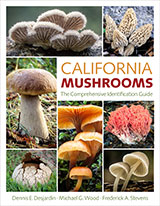The North American Species of Pholiota
157. Pholiota sphagnophila (Pk.) comb. nov.
Naucoria sphagnophila Peck, Bull. N.Y. State Mus. 139: 45. 1910.
Illustrations: Text figs. 347-349.
Pileus 1.2-2.5 cm convex becoming nearly plane, surface minutely appressed fibrillose to faintly squamulose, hygrophanous, tinged flesh color when young and moist, pallid when faded but near pinkish buff in dried material, grayish-ochraceous to rusty-brown when mature.
Lamellae thin, narrow, crowded, subsinuate, unequal, edges uneven, yellowish, becoming ferruginous.
Stipe 2.5-4.5 cm long, 2-3 mm thick, equal, flexuous, solid or at length hollow, yellowish, with a slight floccose tomentum at apex, white-tomentose at base, evenly pale pinkish buff or pinkish buff as dried, as dried thinly coated to near apex with grayish-pallid fibrils, dark fulvous in KOH.
Spores 7-9 x 4-5 µ, smooth, apical pore present but minute (no wall thickening at apex); shape in face view ovate to nearly elliptic, in profile somewhat inequilateral to nearly bean-shaped (ventral line straighter than dorsal line); wall about 0.3 µ thick; color in KOH bright ochraceous tawny singly but fulvous in masses, in Melzer's reagent merely slightly duller than in KOH.
Basidia 4-spored, 18-26 x 6-8 µ, subclavate, ochraceous in KOH and Melzer's reagent. Pleurocystidia 42-73 x 7-12 µ, neck 5-8 µ wide and apex obtuse, narrowly fusoid-ventricose, content ochraceous in KOH and homogeneous to refractive granular, in Melzer's reagent often granular and bright yellow but in some homogeneous; wall thin, exterior often coated with dried coagulated remains of mucilaginous material. Cheilocystidia subvesiculose to fusoid-ventricose, mostly with ochraceous content, wall with adhering mucilaginous material or smooth. Caulocystidia none found.
Gill trama a central area of apparently interwoven floccose smooth hyphae with thin weakly ochraceous walls in KOH, cells becoming variously inflated; subhymenium apparently gelatinous and of narrow interwoven hyphae. Pileus cutis a surface layer of narrow (3-5 µ), smooth scarcely gelatinous hyaline (in KOH) hyphae with thin walls; this intergrading with a tangled layer of wider heavily incrusted rusty brown hyphae at most subgelatinous next to the smooth-walled layer. Context of pale ochraceous thin-walled mostly smooth hyphae with inflating cells. Clamp connections present. All hyphae inamyloid.
Habit, Habitat, and Distribution: Riley's Bog, Stowe, Mass., 30 July 1909, S. Davis (type). Apparently known only from type locality.
Observations: This is a slender Pholiota like P. pulchella, but there is little resemblance between the two microscopically. P. sphagnophila features a very weak development of hyphal gelatinization in the cuticular area of the pileus, the spores lack the thickening around the apical pore which is present in the closely related P. sphagnicola, it has prominent pleurocystidia often coated over the exterior with a coagulated mucilaginous material, and though fusoid-ventricose the ventricose lower part is often not much wider than the neck. The color of the pileus and thickness of the stipe distinguish P. chromocystis immediately.

